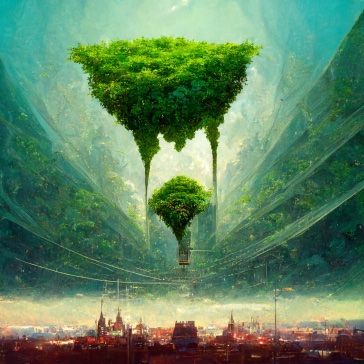Trevor Jones | December 15, 2022

You may have seen an email recently about Vanderbilt being ranked a “top green college” by the Princeton Review. You also may have wondered, “how does Vanderbilt qualify as a ‘green’ college?” Although the university certainly has a long way to go, sustainability has been Vanderbilt’s priority for years. Various technologies have played a role in Vanderbilt’s efforts. From the resources found on this page and Vanderbilt’s off-campus efforts for sustainability, one can see how technology is interwoven at every step.
Energy
Vanderbilt’s efforts to use more sustainable energy revolve around the university’s energy consumption and production on campus. To start, Vanderbilt stopped burning coal in its campus power plant in 2014. Now, the campus uses a Combined Heat and Power (CHP) plant to provide 90% of the heating and 40% of the cooling for the entire campus. Additionally, the use of solar power has been expanded across campus, especially at the Currey Tennis Center. This complex in particular has served as an experimental location for Vanderbilt’s use of solar power; solar power is used to generate electricity and hot water for the center. A dashboard with more detailed information about the center’s solar power system can be found at the bottom of this page.
Green Spaces
In another effort to increase campus-wide sustainability, Vanderbilt has committed to increasing the amount of green spaces on campus in the past decade. The positive results of these efforts can be seen every day around campus. The West End Neighborhood, including Zeppos, Rothschild, and Greek Row, has seen roads replaced with walking trails and extra green space and landscaping added between residence halls and Greek houses. Beyond the addition of new green space, resourceful irrigation has also been a key priority for Vanderbilt. A cistern collects stormwater and repurposes it for irrigation at the top of the Engineering Science Building. Multiple buildings have added Green Roofs, and the Rain Bird IQ system – a smart irrigation system that optimizes rainwater allocation by utilizing many sensors connected through Wi-Fi – has been implemented on campus as well.
Engineering Team Challenge
Through innovation, Vanderbilt students have also taken the reins in solving sustainability problems. In early November, a team of Vanderbilt engineers placed third and won $20,000 for their EcoBuddy product in the Keysight Innovation Challenge 2022. The challenge “was to design an Internet-of-Things device that will help the world reach net zero by 2050 and required each team to be woman-led to encourage gender diversity in STEM”, according to an article on the Vanderbilt School of Engineering’s website. EcoBuddy connects to a car’s onboard computer system and tracks metrics that correlate the owner’s driving habits to fuel efficiency. This technology provides a driver with opportunities to be more environmentally friendly and save money by improving their driving patterns.
Future Work
According to their sustainability homepage, Vanderbilt hit their carbon neutrality goals in Spring 2021 that they had set for 2050. While some might be satisfied with Vanderbilt’s sustainability progress and hitting this goal 30 years early, other students have criticized the university for their methods. Under the surface, however, Vanderbilt achieved carbon neutrality early by purchasing “carbon credits” to offset their emissions, rather than reducing their carbon emissions, as suggested by the term carbon neutrality. The Divest Dores, who call for the divestment of Vanderbilt’s endowment from fossil fuel companies, are a major student organization demanding further action from Vanderbilt. Among their demands for divestment, the organization also asks Vanderbilt to do more to reduce their emissions and fight for true sustainability.
Regardless of your opinion on Vanderbilt’s future regarding sustainability, the progress made so far is commendable, and the technology backing these efforts is groundbreaking. One can only be sure that the Vanderbilt student body and administration will continue to push boundaries on the future state of sustainability, from our on-campus infrastructure to out student design competitions.
Works Cited
Vanderbilt University. (n.d.). On-site energy. Vanderbilt University. Retrieved November 14, 2022, from https://www.vanderbilt.edu/sustainability/on-site-energy/.
Vanderbilt University. (n.d.). Vanderbilt engineering team wins $20,000 internet of things (IOT) challenge. Vanderbilt University. Retrieved November 14, 2022, from https://engineering.vanderbilt.edu/news/2022/vanderbilt-engineering-team-wins-20000-internet-of-things-iot-challenge/ Wolf, A. Vanderbilt ranked a ‘top green college’ by Princeton Review. Vanderbilt University. Retrieved November 14, 2022, from https://news.vanderbilt.edu/2022/11/14/vanderbilt-ranked-a-top-green-college-by-princeton-review/?utm_source=sfmc&utm_medium=email&utm_campaign=MyVU%2BUndergrad%2B11.14.22&utm_term=https%3A%2F%2Fnews.vanderbilt.edu%2F2022%2F11%2F14%2Fvanderbilt-ranked-a-top-green-college-by-princeton-review%2F&utm_id=305741&sfmc_id=49030849
